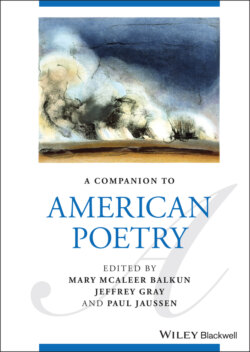Читать книгу A Companion to American Poetry - Группа авторов - Страница 27
NOTES
Оглавление1 1. For early discussion of African music, see for example, the commentary by Prince Henry the Navigator cited in Epstein, p. 3, n. 3; and the report from sea captain Richard Jobson and excerpts of Mungo Park’s Travels in the Interior Districts of Africa in Southern, Readings in Black American Music, 5–6. For discussion of communication, singing, and dancing during the processes of kidnap and travel on slave ships, see Rediker’s The Slave Ship: A Human History, and Ring Shout, Wheel About: The Racial Politics of Music and Dance in American Slavery by Katrina Dyonne Thompson.
2 2. These adjectives are frequently used in the early commentaries on the spirituals such as those cited here. For example, Higginson (1870) refers to them as “barbaric,” “quaint,” and “plaintive.” George MacDonald (1873) calls them “pathetic,” “rude,” and “comic.” T.L. Cuyler cited by J.B.T. Marsh (1875) describes them as “wild melodies.” Seward (1872) calls them “strange” and “childlike”.
3 3. Some major collections of the spirituals from both early and later periods include Slave Songs of the United States, ed. Allen et al. (1867); Christy’s Plantation Melodies: Originator of Ethiopian Minstrelsy and the First to Harmonize Negro Melodies, ed. E.P. Christy (1851); Higginson’s Army Life in a Black Regiment and Other Writings (1870); The Story of the Jubilee Singers; with Their Songs, ed. J.B.T. Marsh (1875); Old Plantation Hymns: A Collection of Hitherto Unpublished Melodies of the Slave and the Freeman, with Historical and Descriptive Notes, ed. William R. Barton (1899); Religious Folk-Songs of the Negro as Sung at Hampton Institute, ed. R. Nathaniel Dett (1927); The Oxford Book of Spirituals, ed. Moses Hogan (2002); The Books of American Negro Spirituals, ed. James Weldon Johnson and J. Rosamond Johnson (1926); Jubilee Songs: As Sung by the Jubilee Singers of Fisk University, ed. Theo. F. Seward (1872); The Carolina Low-Country, ed. Augustine T. Smythe et al. (1931); Freedom’s Lyre: or, Psalms, Hymns, and Sacred Songs, for the Slave and His Friends, ed. Edwin F. Hatfield (1840); and Folk Song of the American Negro, ed. John Wesley Work (1915). With a few exceptions like the volume by Hogan, note the dominant time frames of collecting and publishing the spirituals. Some landmark critical texts (representing widely diverse perspectives coming from multiple periods) on the history and origins of spirituals include The Spirituals and the Blues by James H. Cone (1999); Culture on the Margins: The Black Spiritual and the Rise of African American Cultural Interpretation by Jon Cruz (1999); Sinful Tunes and Spirituals: Black Folk Music to the Civil War by Dena J. Epstein (1977); Negro Slave Songs in the United States by Miles Mark Fisher (1953); Wade in the Water: The Wisdom of the Spirituals by Arthur C. Jones (1993); Afro-American Folksongs: A Study in Racial and National Music by H.D. Krehbiel (1913); The Singing Campaign for Ten Thousand Pounds: Jubilee Singers in Great Britain by Rev. Gustavus D. Pike (1875); Protest and Praise: Sacred Music of Black Religion by Jon Michael Spencer (1990); Deep River and the Negro Spiritual Speaks of Life and Death by Howard Thurman (1975); Dark Midnight When I Rise: The Story of the Fisk Jubilee Singers: How Black Music Changed America and the World by Andrew Ward (2000); Slave Songs and the Birth of African American Poetry (2008) and A History of African American Poetry by Lauri Ramey (2019); extensive writings in numerous books written and edited by Eileen Southern; and the indispensable and comprehensive Black Song: The Forge and the Flame: The Story of How the Afro-American Spiritual was Hammered Out by John Lovell, Jr. (1972). It would also be remiss not to mention the invaluable Chapter XIV, The Sorrow Songs, in The Souls of Black Folk by W.E.B. Du Bois (1903).
4 4. Ramey 2008, pp. 102–103.
5 5. Ramey 2008, pp. 48–49.
6 6. Johnson and Johnson 1925, p. 15.
7 7. The editorial apparatus of Slave Songs of the United States (ed. Allen, Ware, and Garrison) acknowledges that these are mere approximations that fail to adequately reproduce the spirituals. In the Introduction, Allen wrote: “The best we can do, however, with paper and types … will convey but a faint shadow of the original…. [T]he intonations and delicate variations of even one singer cannot be reproduced on paper. And I despair of conveying any notion of the effect of a number singing together” (1867, pp. iv–v). In a letter to the editor of Dwight’s Journal of Music, Lucy McKim (Garrison) provides this naturalistic comparison: “[t]he odd turns made in the throat; and the curious rhythmic effect produced by single voices chiming in at different irregular intervals, seem almost as impossible to place on score, as the singing of birds, or the tones of an Æolian Harp” (21 [November 8, 1862]: 254– 255).
8 8. “Come to Jesus” and semantically similar phrases appear often in the spirituals, including “Steal Away” whose refrain contains the phrase “steal away home to Jesus.” The use of “Come to Jesus” in stanza 6, line 2, is followed by “Sinnahs tremblin’” in line 3, which evokes both “Steal Away” and “Were You There?”.
